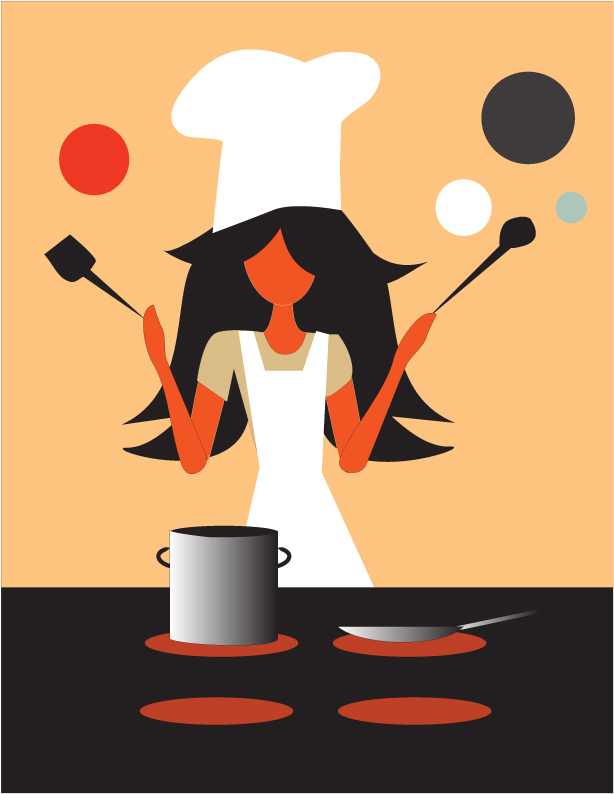By Lori Popkewitz Alper
Mom’s Clean Air Force
We live in a culture where fast food has become the norm. You don’t have to look far to find a drive-through on most corners throughout the country. Cooking hacks and simple recipes boasting prep times of under 15 minutes are in demand because we, as a culture, are looking for convenience and simplicity.
The same holds true for our cookware. Many kitchens are filled with nonstick pots and pans, which are loved for their ease and convenience when it comes to cooking and cleaning.
Nonstick finishes have come under fire in recent years due to the toxic fumes emitted when the cookware is exposed to high heat. Those nonstick advantages are taking a backseat and many health conscious families are now opting for a safer alternative.
The Science Behind Nonstick
Most nonstick pots and pans are metal pans (such as aluminum pans) coated with a chemicals from the Perfluorinated chemical or Perfluorochemicals (PFC) family. One of those chemicals is the synthetic polymer called polytetrafluoroetheylene (PTFE), also known as Teflon. Perfluorooctanoic acid (PFOA) is another chemical from the PFC family and is used in the process of making PTFE.
Teflon is a brand name (DuPont trademarked the process and the chemical in 1945) for a the man-made PTFE.
The Problem with Nonstick
According to the Environmental Working Group (EWG), toxic fumes from the Teflon chemical released from pots and pans at high temperatures may kill pet birds and cause people to develop flu-like symptoms. When nonstick pans are overheated the coating may begin to break down and toxic particles and gases can be released into the air that we breathe.
The Issue Then Becomes How Hot is too Hot?
Knowing that nonstick surfaces can release toxic fumes when they’re heated at high heat isn’t enough. The question now becomes:
How do we know when our pots and pans are too hot?
I would venture to say that most of us have no idea how hot our pots and pans are when we’re cooking.
The Environmental Working Group commissioned tests conducted in 2003 showed that in just two to five minutes on a conventional stove top, dry cookware coated with Teflon and other non-stick surfaces could exceed temperatures at which the coating breaks apart and emits toxic particles and gases.
Nonstick Pots and Pans and Your Health
Studies in humans found that workers with exposure to PFOA have higher risks of bladder and kidney cancers. Another study showed that PFCs have been linked to infertility in women. Chemicals from the PFC family are associated with smaller birth weight and size in newborn babies, elevated cholesterol, abnormal thyroid hormone levels, liver inflammation and weakened immune defense against disease.
Safer Alternatives to Nonstick Pots and Pans
There’s good and bad news. Thankfully there are safer alternatives to nonstick cookware out there, but even the safer options can sometimes be problematic.
Cast Iron
Using the cookware that your grandparents probably used is a great alternative to Teflon. Cast iron is known for its durability and even heat distribution. The downside of cast iron – most cast iron cookware needs to be seasoned after each use and this makes it not as worry-free as other alternatives. It also can leach iron into your food. If iron in your diet is an issue cast iron might not be the best choice for you.
Stainless Steel
Stainless steel is a mixture of several different metals, including nickel, chromium and molybdenum, all of which can trickle into foods. Leaching will happen only if your stainless steel cookware is dinged or scratched and the amount of leaching would be small. Cleaning your stainless steel cookware can be tricky. Soaking after use and before scrubbing is a must. HERE is a simple way to clean stainless steel.
Ceramic
Ceramic cookware is considered safe and easy to clean in the dishwasher as long as it has zero lead content. It’s important to check any pans with glaze for possible lead. According to the National Institutes of Health, “any ceramic cookware bought in another country or considered to be a craft, antique, or collectable may not meet FDA specifications, and should not be used to hold food. Test kits can detect high levels of lead in ceramic cookware, but may not detect lower levels that may also be dangerous.”
Glass
Glass cookware is an option if not exposed to extreme temperatures. Most glass is inert, nontoxic, and safe unless it has a coating. If there is some form of coating, it’s important to confirm that there’s no lead present.
Our current chemical safety law, the Toxic Substances Control Act of 1976, is badly broken. It allows chemicals, like Teflon, onto the market without adequate safety testing. It’s time to change that.



